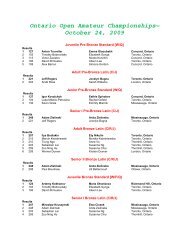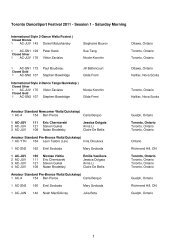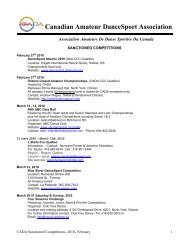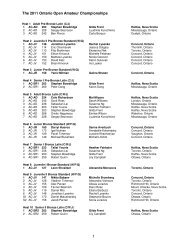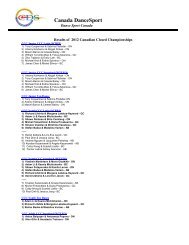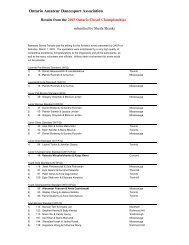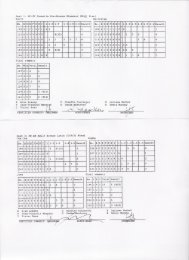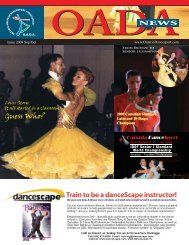Download OADA E-newsletter - Ontario Dancesport
Download OADA E-newsletter - Ontario Dancesport
Download OADA E-newsletter - Ontario Dancesport
Create successful ePaper yourself
Turn your PDF publications into a flip-book with our unique Google optimized e-Paper software.
Hailing from two of the main dancing capitals in Canada, we<br />
had launched ourselves into an inter-provincial partnership.<br />
Now if you thought a couple had it difficult enough working<br />
together normally, imagine then a couple with a six hour distance<br />
in between them. Due to academic restrictions and having<br />
to attend school regularly on weekdays, that only left us with<br />
two days on the weekend to dance. Resorting to travelling by<br />
train for efficiency, a one way trek took about five hours. With<br />
a back and forth trip that one of us would take every Friday, we<br />
only had forty-eight hours minus ten hours of travel, eighteen<br />
hours of sleep, time to eat and do homework, leaving about ten<br />
total hours to practice for an<br />
entire week. We worked at<br />
that sluggish pace for about a<br />
year, taking precious holidays<br />
to extend practice. But even<br />
when we managed to scrounge<br />
up the time for practice, it was<br />
a bit worse then it seemed.<br />
Quite simply, I am an Anglophone<br />
and Sarah-Maude is a<br />
francophone. Besides the cultural<br />
aspects, we did not even<br />
speak the same language.<br />
Sarah-Maude is a French-<br />
Canadian girl blending in an<br />
all English speaking city.<br />
Our first few lessons were<br />
a mix of hand signals with my<br />
poor translation and bi-lingual<br />
skills being more of a burden<br />
then a blessing. I don't know<br />
if it was the improvement of<br />
my French or our sheer will<br />
power that kept us going.<br />
Time slowly rolled along and<br />
Sarah-Maude soon enrolled in<br />
a special sporting school in<br />
Montreal allowing her to<br />
study in distance. She received<br />
oversaturated workloads<br />
because she would be missing days spent in class in order to use<br />
them to stay in Toronto and practice more often. However the<br />
world had not stopped revolving to accommodate us. The<br />
average couple we were competing against had double if not<br />
triple the amount of lessons and time spent on the dance floor.<br />
Combined with our respective responsibilities, organizing ourselves<br />
a city apart, and being home sickness, our dancing was<br />
very raw. We were always riding second or third place despite<br />
all the extra weight we carried as a duo, and our outstanding<br />
hard work only allowed us to keep up with the surrounding<br />
crowd. But together we never stopped and continued on in spite<br />
of our situation.<br />
Summers came and improvement along with it. We began<br />
taking consistent lessons with structured practices and reformed<br />
our strategies. It is said that all great things desire a single crucial<br />
ingredient. Time and this had proven to be true. Skipping<br />
ahead to present day, a lot has changed since those early months.<br />
Sarah can speak perfect fluent English while I can at least understand<br />
French... decently. We improved from eventually dancing<br />
four days per week to Sarah temporarily residing in Toronto,<br />
studying CJEP in distance and returning for evaluations and<br />
business. I reworked my last year of high school so as to have<br />
class end earlier in the day, allowing us to practice from the<br />
afternoon to night time including work and extra-curriculums.<br />
We converted our squeezed practices of ten hours a week to<br />
about six hours in a single<br />
day. As for the five hundred<br />
kilometer gap, it is now<br />
closed but along with that<br />
benefit comes many other<br />
trials. Both of us no doubt<br />
matured much faster than<br />
most teenagers our age, realizing<br />
that dancing is a<br />
lifestyle early rather than just<br />
a timely hobby.<br />
To achieve success, we<br />
handle all our own organizational<br />
duties, juggle our personal<br />
finances, and generally<br />
behave as the adult version of<br />
ourselves five or six years<br />
down the road. Our training<br />
depends on personal discipline,<br />
respect, mutual collaboration<br />
and motivation; and<br />
not on having our parents<br />
there to drive us to the studio,<br />
pack our lunches, or force us<br />
to practice and be nice to one<br />
another. It is indeed a very<br />
intimate struggle for two<br />
people from different parts of<br />
the country to work together<br />
in such a unified manner,<br />
especially in this stressful sport. There were many tough times<br />
physically, emotionally, and mentally but for the matter of interprovincial<br />
partnerships, I believe that Sarah-Maude and I have<br />
conquered them together.<br />
We are about to face new challenges when we enter our<br />
first year dancing in the Amateur category. However, the battles<br />
that were fought during our period of road trips have definitely<br />
given us the resolution to train harder than before to<br />
become true competitors in the upcoming phase of our dancing<br />
careers. In closing I would like to thank all our family members,<br />
colleagues, and coaches Alex Chalkevitch & Larissa<br />
Kerbel, my brother Kamil Studenny & Katya Trubina, and<br />
lastly a dear friend of ours, Paulina Cheng, for giving us this<br />
interviewing opportunity.<br />
<strong>OADA</strong>NEWS 11/12 2009 | 7



